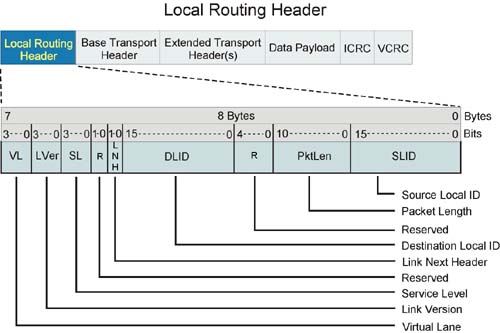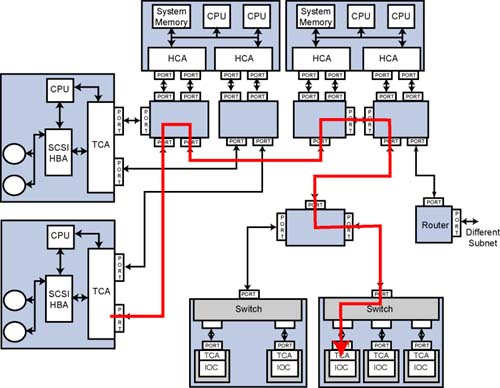LID's Purpose: Packet Routing Within Subnet
Assigning a LID to a port permits it to be addressed as the target of a packet. In Figure 7-2 on page 136 a packet is sent from a port on one TCA to a destination port on another TCA:
The source TCA composes the packet including a Local Route Header (LRH; see Figure 7-1 on page 135) with the DLID and SLID values set as follows:
- LRH:DLID set to one of the LID addresses assigned to the destination TCA port.
- LRH:SLID set to one of the LID addresses assigned to the TCA port sourcing the packet into the fabric.
Figure 7-1. Intra-Subnet Packet Format

The source TCA injects the packet onto the link.
The packet arrives at a port on the first switch in the path to the destination port.
The switch port's Link Layer examines the packet's LRH:DLID to determine if the address is a unicast or multicast address:
- If it's a unicast address (it is within the range from 0001h–BFFFh), then the port's Link Layer performs a lookup in its Forwarding Table (an attribute that was set up by the SM earlier in time). The DLID selects a table entry that indicates the switch port through which the packet is to be output.
- If it's a multicast address (it is within the range from C000h–FFFEh), then the port's Link Layer behaves as described in “IBA and Raw Packet Multicast” on page 124.
As can be seen in the illustration, the packet traverses a total of five switches before arriving at the destination TCA port.
Upon arrival at the destination TCA port, the port's Link Layer logic decodes the packet's DLID field and determines that it is the destination port. The packet is therefore passed to the TCA's Network Layer for additional processing.
Figure 7-2. LID's Purpose: Packet Routing Within Subnet

